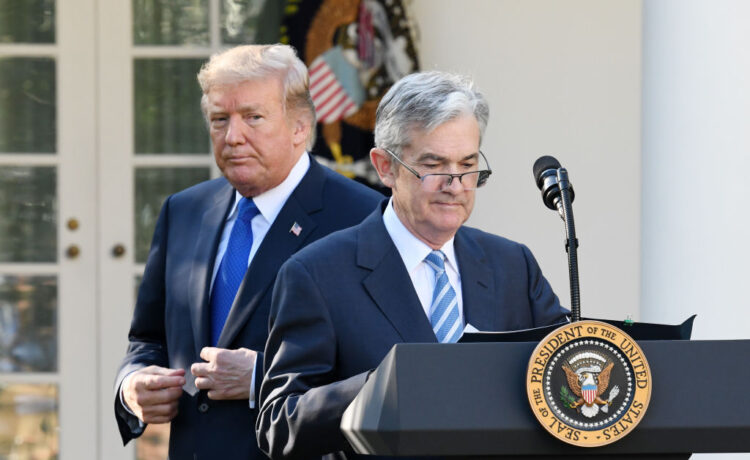Does President Donald Trump have the authority to fire Federal Reserve Chair Jerome Powell? A pending Supreme Court review of a 90-year-old case could provide an answer as soon as this summer.
But investors, traders and speculators are already pricing in their discomfort with the very question and its potential to undermine the independence of the world’s most important central bank.
Indeed, whatever Chief Justice John Roberts and the eight other members of the highest court in the United States of America decide, the president is going to post his way through it.
Sign up for Kiplinger’s Free E-Newsletters
Profit and prosper with the best of expert advice on investing, taxes, retirement, personal finance and more – straight to your e-mail.
Profit and prosper with the best of expert advice – straight to your e-mail.
That could include Trump trying to fire Powell no matter what Roberts says.
Trump v. Powell
President Trump’s April 2 “Liberation Day” tariffs announcement had already generated unprecedented levels of volatility in both stock and bond markets.
In an April 16 appearance at the Economic Club of Chicago, Fed Chair Powell described the uncertainty from a central banker’s perspective. “These are very fundamental policy changes,” Powell said. “There isn’t a modern experience of how to think about this.”
Noting that “the level of the tariff increases announced so far is significantly larger than anticipated,” Powell explained that the Fed may find itself in a challenging scenario where its dual-mandate goals are in tension.
Because of Trump’s policy, “unemployment is likely to go up as the economy slows,” and “in all likelihood,” inflation is likely to go up as well.
Trump responded the following morning with a post on Truth Social calling for the Fed chair’s “termination” and has continued to use his social media platform to disparage Powell.
Meanwhile, a series of articles in The Wall Street Journal and The New York Times have detailed months of conversations between Trump and various White House aides about firing the Fed chair.
On April 17, the WSJ reported that during an April 15 Oval Office meeting, Trump said, “If I want him out, he’ll be out of there real fast, believe me.”
And, at 9:41 am Eastern Daylight Time on April 21, the president took to Truth Social to vent about Powell again, intoning “‘Preemptive Cuts’ in Interest Rates are being called for by many” and arguing “there can be a SLOWING of the economy unless Mr. Too Late, a major loser, lowers interest rates, NOW.”
The Dow Jones Industrial Average was down 971 points on April 21. The yield on the 10-year U.S. Treasury note ticked up to 4.409% from 4.327%. And the U.S. Dollar Index declined by 1.1%.
Since April 2, the Dow is down 9.6%, the yield on the 10-year U.S. Treasury note has risen by more than 20 basis points, and the dollar has depreciated against a basket of developed-world currencies by 5.6%.
Such dynamics suggest that “Can Donald Trump fire Jerome Powell?” is little more than an academic question and that the president is well equipped to undermine the perceived independence of the Fed even absent niceties such as formal constitutional authority.
Analysts v. Trump
“Trump’s renewed attacks on Fed Chairman Jerome Powell raise policy uncertainty but are unlikely to lead to Powell’s removal,” writes BCA Research macro strategist Felix Vezina-Poirier.
Noting that Powell’s term runs through May 2026, Vezina-Poirier says firing him at this point would be “complex, politically risky, and legally lengthy and difficult.” Powell also represents a “politically convenient scapegoat” for Trump as sentiment on the economy and markets slide.
“Moreover,” the strategist explains, “firing Powell would likely backfire by pushing long-term Treasury yields higher, contradicting the administration’s stated preference for lower yields.” He adds that “potential replacements … would generally lean toward tighter monetary policy, not the easier stance Trump desires.”
Powell’s stated priority is to ensure inflation expectations remain well anchored. He feels he has room for patience on the growth side. And there will be no “Powell Put” to save the stock market.
Vezina-Poirier concludes that “Powell’s removal would prompt an immediate bear steepening,” which means markets would “price in higher term premia and inflation” in the form of higher interest rates.
“Even if the noise regarding Powell were to decline,” suggests the forex research team at Barclays, “the dovish pressure on the Fed could persist, which would likely further erode market confidence in the integrity of the greenback.”
Humphrey’s Executor v. United States
Even as markets price in more Trump-related uncertainty, there may be a special place for the Fed in Supreme Court jurisprudence.
The Court’s 1935 decision in Humphrey’s Executor v. United States protects heads of executive branch agencies – a category that includes the Fed – from being fired by the president absent a showing of good cause, such as severe misconduct and/or gross incompetence.
It’s on the docket again because in its first weeks, the second Trump administration fired several people from their positions with independent executive agencies.
And, in February, acting Solicitor General Sarah Harris told Congress that the administration planned to challenge the precedent.
As Georgetown University Law Center Professor Stephen Vladeck explained to ScotusBlog’s Ellena Erskine in an April 10 Q-and-A on the issue, this is the first time the Justice Department has taken the position that Humphrey’s Executor should be overruled.
But this is not the first time the Court has had an opportunity to overrule it. Vladeck concedes “that there are more than two votes to overrule Humphrey’s Executor” but says “the most important data point here is that the court has thus far resisted invitations to do so.”
Vladeck cites “an unspoken but widely shared view that the independence of the Fed (and no other agency) is really important.”
As the law professor sees it, the Trump administration must provide a coherent rationale to overturn Humphrey’s Executor in a way that doesn’t also undermine the independence of the Fed, “thereby risking yet further harm to the stability of our economic system.”
Vladeck does expect the Court to use the current cases to resolve the Humphrey’s Executor question. “If nothing else,” he concludes, “it seems increasingly likely that the fate of Humphrey’s Executor will be resolved before the justices rise for their summer recess.”
It seems at least as likely President Trump will post more about the failures of and firing Fed Chair Powell between now and then.





